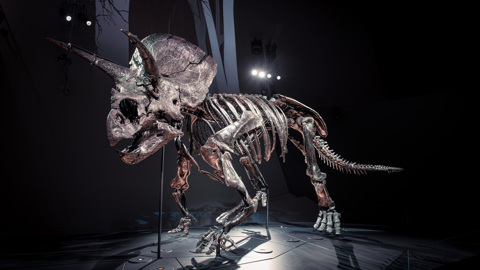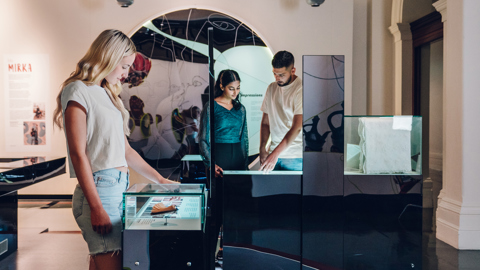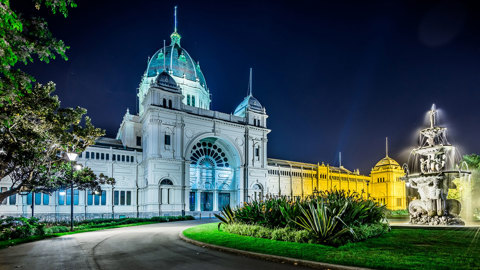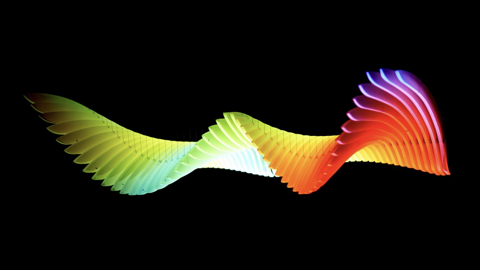Theatre Studies Design Films
Transcript
Poppy Holden's Theatre Studies Design project consists of a set and props for a stage production of 'The Curious Incident of the Dog in the Night-time'. Poppy has developed, and here demonstrates, a set of cubes which the actor stacks and repositions throughout the performance; to create the space, suggest order or chaos, and present a mount for a variety of images and representations key to plot or character. Seven small cardboard cubes are scale models of a full-sized wooden version, which stands at knee-height, and can be moved and lifted by cut-in handles. Purposefully naive icons, reflecting the interests of the teenage protagonist, Christopher Boone, can be added to the cube's presented face to work alone or connect with other cubes like a puzzle. These include a red car, tracks, and fragments of envelopes bearing addresses and English postal marks. The cubes' all-over graph paper rendering evokes another of the protagonist's focuses - A Level Maths.
Props, stored inside the cubes, include an oversized green book, used by the actor to signal prominence and narration. The 43 letters which form a key plot device are presented as 2 garlands of 21 envelopes and a single envelope. The garlands create volume and the possibility of movement in a more fluid way than the structural cubes.
Ewan Healy's production design for Shakespeare's 'Hamlet' comprises dynamic components to form a set, and Hamlet's costume, who’s shared shapes and materials create a striking and cohesive effect. Together in one configuration, the three set components form a the shape of a jagged crown: a central symmetrical piece flanked by two pieces, whose fang-like protrusions taper away in opposite directions. These panels are made from a mirrored acrylic, which reflects back to the audience a fragmented glimpse of a rear perspective not often afforded to them. The acrylic's properties enable the necessary rigidity without excess weight. Along with built-in wheels, this allows the pieces to be safely and easily moved throughout the performance. Another configuration - pivoting each of the flanking pieces around the symmetrical piece, creates a throne. As Hamlet sits on the throne, it presents multi-faceted reflections of his face and body.
The costume features three main elements: A coronet of a dull black, with two dimensional, tree-like upwards protrusions, and fragments of the same mirrored acrylic used for the set, reflecting Hamlet's shattered psyche at this point in the play. The rigid silver-coloured brigandine and breastplate, overlaid with entwined climbing plants and angular shards of silver acrylic, together representing the garden scene of his father's death. Ewan explains in his exhibitor statement that "This moment marked the beginning of the play, and thus is integral to the subtextual design of the costume." The shared shapes and materials of the set and costumes create a cohesive effect.
Hannah Toniolo’s Theatre Studies Design project provides a set and costume for Melissa Reeve’s play, ‘Salt Creek Murders’. The set consists of a cubicle on wheels. The side facing out to the audience is painted with a flat, frontier landscape of brown earth and pale sky divided by a dado rail. A framed oil painting of a tree-hemmed creek hangs on one side. Adjacent to three hooks. From one hook dangles a limp toy rabbit smeared blood red. Sprigs of desert shrub placed in front of the 2-dimensional landscape provide depth and perspective. A door signed ‘staff only’ opens outward from one side of the set. The character of Nellie emerges from the door, closes it behind her, briefly takes down the limp rabbit then sits on the upturned crate. She wears a floor-length, sage-green dress in keeping with the style of the era in which the play is set (the 1850s). The dress has a high v-neckline, buttoned bodice and balloon sleeves that cinch in at the wrist with buttoned cuffs. The dress’s skirt flares outwards, given added structure by the white petticoat just glimpsed beneath the hem. A green ribbon and blood-spattered white apron encircle the waist.
Clara Verbeek’s Theatre Studies Design project consists of a multi-piece costume and key prop for a theatrical staging of Philip Pullman’s book (and later play), ‘His Dark Materials’. The costume is for the character of Iorek Byrnison, one of the polar-bear-like panserbjørns, who, unlike his fellows ‘armoured bears’ is devoid of armour. First, Clara demonstrates the paws, made from acrylic white fur, and worn like gloves and socks. Each finger of the oversized gloves is tipped with a black claw. The palm of each glove is cut away allowing the wearer use of their own fingers outside of the glove’s confines. Appliqued PVC shapes on the underside of the ‘foot’ paws recreate the functional padding of bears’ paws. More costume components are displayed on a mannequin. A head piece shaped like the upper portion of an elongated skull. A black PVC catsuit is appliqued with pink ‘claw’ scratches over the chest, waist and upper arm and a patch of white acrylic fur. An exposed spine runs down the centre back of the catsuit. White ribs snake around the waist, hips chest and arms, as though clinging onto the wearer like an exoskeleton. Some of the ‘ribs’ are malleable, enabling the costume to expand to symbolise the character’s growth. A separate fabric prop is transformable: In one iteration a tapering bottle, in another, a hilt-like smoke-leaf tin. The transformation from the bottle to the tin is achieved by turning the item inside-out.






